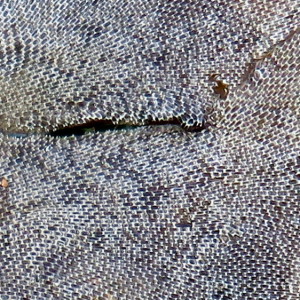Little boxes
Another blip about kelp (see January 23rd)
I brought some home from the beach to examine more closely (it's in the bath now) in particular the pallid crust of material I've often noticed on the surface of the fronds, forming these irregular shapes. When magnified the stuff appears to be formed of tiny sections knitted together like chain mail (see extra).
Turns out this 'sea mat' is formed by a colony of bryozoans: microscopic animalcules that multiply from an initial singleton to a colony of maybe millions locked together without a separate existence. The way the process begins seems almost incredible.
"The tiny larval bryozoan is a clamlike swimmer in a bivalve shell. Opening its shell like an umbrella, it parachutes down onto a clean kelp blade. Alert for chemical cues, the bryozoan tests the surface, then cements itself to the blade with a sticky glue. The youngster settles in place and changes to its adult form, a captive within its own shelled rectangular fort. Once established on the kelp, the lone settler begins to multiply. Budding off clones in neat rows, a colony fans out to frost the blade with a crust of the tiny animals. Bryozoan colonies are important food sources for some sea slugs and fish.
Bryozoans possess a unique feeding structure called a lophophore. The lophophore is a U-shaped or circular ring of ciliated tentacles used for filter feeding. Extending a crown of tentacles above its shell, the bryozoan flicks its tentacles through the water to catch bits of food."
You can actually see them doing this here (but be warned, you might want to turn off the sound.)
The idea of all these static individuals locked together in their tiny cells brought into my mind the song Little Boxes which I haven't heard for years.
Turns out it was the work of Malvina Reynolds, whose life as a singer-songwriter, socialist, political activist and proto-feminist was anything but boxed in.


Comments
Sign in or get an account to comment.


